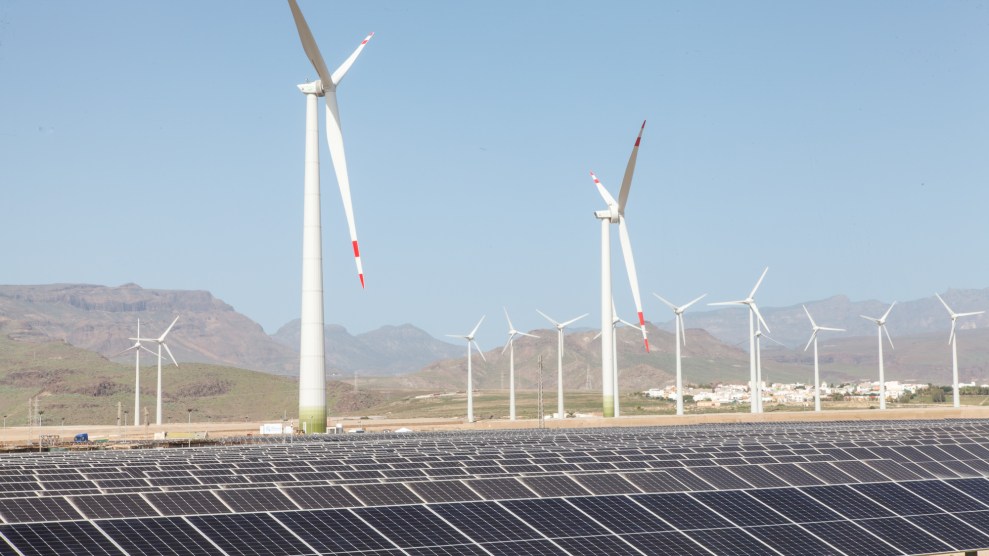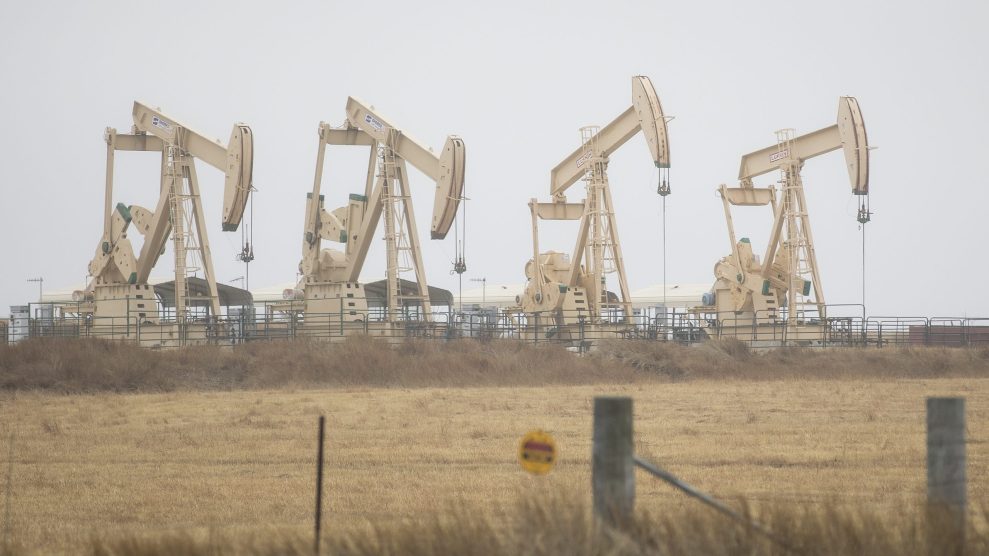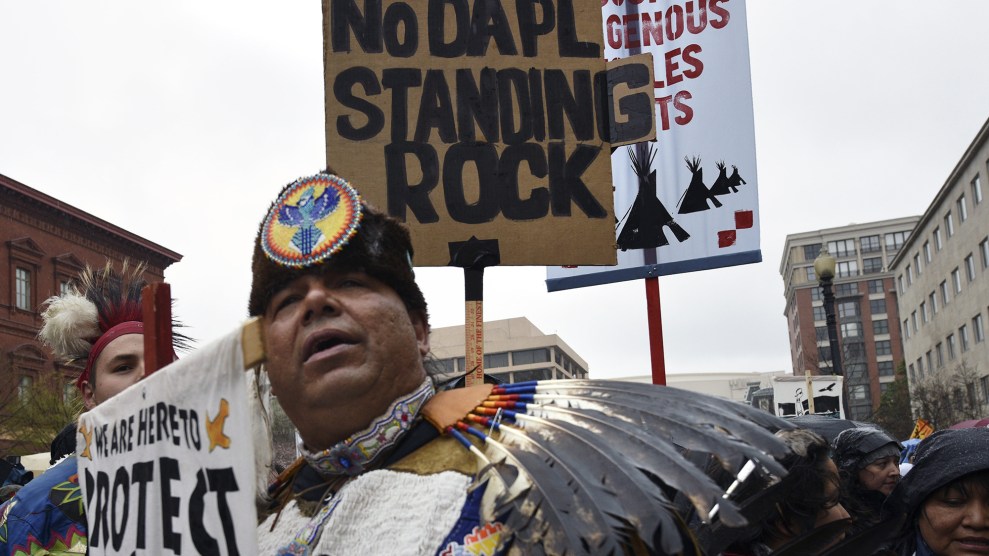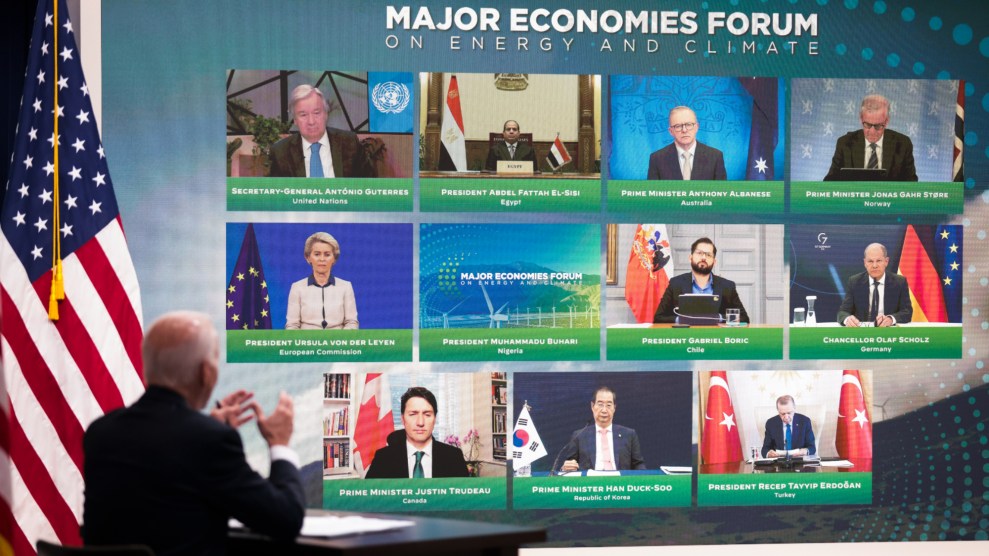
New wind and solar installations are generating more than enough power to cover the increase in global demand.Europa/Getty
This story was originally published by Inside Climate News and is reproduced here as part of the Climate Desk collaboration.
The global energy transition has reached a pivot point, in which fossil fuels have likely peaked in their use for producing electricity and are about to enter a period of decline.
This is the idea at the heart of a new report from RMI (Rocky Mountain Institute), a nonprofit that does research and advocacy about the transition. The lead author, energy analyst Kingsmill Bond, makes a case that wind and solar power are going through growth that looks almost exactly like the trend lines for the early stages of transformative products and industries, across technologies and eras, like automobiles and smartphones.
The growth begins slowly, with high costs, and shifts into high gear as costs shrink and efficiency rises. The optimism in this outlook is almost jarring in its clarity, and in its contrast with the pessimism I see and feel every day as the threats of climate change become clearer.
The report argues that the fossil fuel demand has peaked in the electricity market in part because the annual growth in global electricity demand—about 700 terawatt-hours—is less than the electricity generated in 2022 by newly built power plants that have zero emissions, most of which were wind and solar plants. The report cites forecasts for a continuing increase in wind and solar development that will outpace the growth in electricity demand, a dynamic that will squeeze out the most expensive and dirtiest energy sources.
The use of fossil fuels for electricity shifted in 2018 from a long period of growth to a plateau in which there is no clear trend up or down as measured by the amount of electricity produced. The report says the plateau is likely to continue until about 2025, followed by a long-term decline.
The report acknowledges some big obstacles, like political resistance from fossil fuel industries and the challenges of running a grid that uses mostly intermittent resources. But it says the obstacles are surmountable, although I think this portion of the report feels insubstantial at points, with statements like “Innovation has solved most of the barriers to change.” (Bond acknowledged this is fair criticism, and said that the part of the report about obstacles is brief because he and his co-authors are working on a companion report that focuses on this subject in detail.)
The report isn’t an academic paper, but plenty of academic researchers have used similar concepts to come to similar conclusions. For example, I wrote last year about a paper from University of Oxford economists and mathematicians about the potential for vast cost savings from a rapid transition to renewable energy.
Bond, who is based in the United Kingdom, spent decades as an equity analyst and strategist for Deutsche Bank and Citibank, among others. He shifted a few years ago to focus exclusively on economic ramifications of the transition to clean energy, working for the UK-based Carbon Tracker Initiative and now RMI.
I spoke with him by video from his office, with follow-up via email. Here’s our discussion, edited for length and clarity:
A lot of what you’re talking about feels like techno optimism, this idea that we can all relax because progress is going to solve everything. And that’s an idea that gets a lot of criticism, especially from environmental advocates.
I hear what you’re saying that maybe we are understating the difficulties that we face. There’s nothing inevitable about change. We cannot relax for a moment. This is a battle between the forces trying to protect the fossil fuel status quo and those trying to change it. We have to go out there and drive the change we need. Change the policy, deploy the renewable technology, come up with solutions in the hard-to-solve sectors. There is nothing easy about this, but we still need hope and direction. As [Paul] Romer said, it’s the difference between complacent optimism and conditional optimism, the difference between a child wanting to be given toys and a child going and building a treehouse.
How has the Ukraine war affected the trajectory of the energy transition?
So the Ukraine war without any question has sped up change because it increased efficiency and sped up the deployment of renewables. The International Energy Agency, for example, put out two reports at the end of 2022, and one of them said that after a number of years of slow gains in energy efficiency, efficiency has increased this year to 2 percent, which is exactly what you would expect in the face of a supply shock. And that, of course, is just the beginning. So it’s increased the efficiency of our use of energy. And of course, the other thing that it’s done is it’s massively increased the deployment of renewable energy. So the IEA, for example, increased their renewable energy deployment forecast for the next five years by 30 percent. Meanwhile, solar deployment in 2022 increased by 50 percent to 270 GW, according to BloombergNEF, and EV sales rose by 60 percent. As so often, war has sped up change.
So if I’m Vladimir Putin, this is pretty counterproductive in terms of my long-term global interests.
As Talleyrand said, it was worse than a crime, it was a mistake. The situation was similar in the 1970s, when OPEC tried to achieve its own geopolitical aims by cutting off oil supply, and ended up setting the scene for two decades of significantly lower oil prices, which ultimately had very profound consequences, including contributing to the collapse of the Soviet Union. This time around, we see a similar story of petrostate overreach leading to a speeding up of change. It’s not an unreasonable framework for us to be thinking about the consequences of Putin’s invasion of Ukraine, that it will actually achieve the exact opposite of what he wanted, that is to say, a speeding up of change.
Back to the idea of optimism: We live in a world where there’s a lot of justified pessimism about climate change. Are you optimistic about the world that our children and grandchildren will be living in?
The reason I’m very optimistic is because we can actually see right in front of our noses this pivot point where we go from constantly rising demand for fossil fuels, to a plateau, and then a decline.
Four factors underlie my optimism: learning curves, meaning the cost of renewables gets cheaper every year; exponential growth, meaning renewables get bigger every year; tipping points, because they are happening right now; and feedback loops, which make change happen faster once you get to the tipping point. That means that this is the decade of disruption, where the energy system starts its long process of change. And as the energy system changes, we can fight back against climate change.
One of the other reasons why I’m optimistic is if you look backwards 10 years, it really was incredibly bleak. And all these technologies were much more expensive. But here we are, and what will happen in another 10 years, how much more innovation and deployment can there be? So yeah, I guess that’s why I’m relatively optimistic. And I should also say I have two children who share this optimism; they’re going into this field, as engineers to build out this brave new world.















